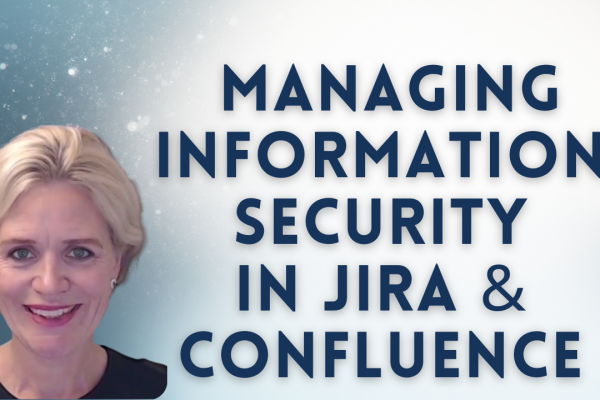What is a Risk Register and Where to Build It?
Risk Management is an essential governance practice for enterprise, product, portfolio, information security and project management. Proactive risk management ensures that the most significant risks that could impact the organization’s objectives are effectively mitigated.
The document where an organization or a risk manager records all identified risks, their analysis, mitigation plans, and ownership details is commonly referred to as a Risk Register. It is a centralized tool for monitoring and managing risks throughout a project or organizational risk management process.
For many organizations, Risk Register is still being built and manually maintained in a MS Excel spreadsheet that a Project Coordinator or Risk Manager tries to keep updated.
The 3 main issues with manual risk management in Excel are:
- Risk related data is not up to date,
- Human errors when entering data,
- Complete lack of audit trail, i.e. what has happened to risks throughout their lifetime.
These issues may result in incorrect risk prioritizations and risk reports which, in turn, may lead to critical risks with severe consequences being ignored.
Why is Jira Perfect for Risk Management?
When it comes to managing risks, Jira offers a robust platform with various features that help project managers track and mitigate potential issues. Configuring dedicated Jira plugins for optimal risk management can further enhance its effectiveness.
With the risk management plugins on Jira, project managers can identify and track risks throughout the project lifecycle. Most of these plugins offer support for various risk management frameworks, making it easier to implement either industry standards like ISO 31000, PRINCE2, ISO 27001 and ISO 14971, or internal policies. These templates streamline the risk assessment process, focusing on specific project needs.
There are several reasons why dedicated risk management tools should be used for building Risk Registers and why we advocate using risk management tools native to Jira where the rest of your software development is taking place:
- Each Risk has its Owner & Followups are Automated
Instead of manually tracking the risk mitigation actions from responsible people, assign risks to their owners so they can keep track of everything themselves. Perpetually chasing nominated Risk Owners to see if something’s been done is very time consuming and can be a full time job of its own.
Having risk items in Jira allows the Project Manager also to create automation rules (available out-of-the-box) for sequenced follow-up of outstanding tasks to a due date.
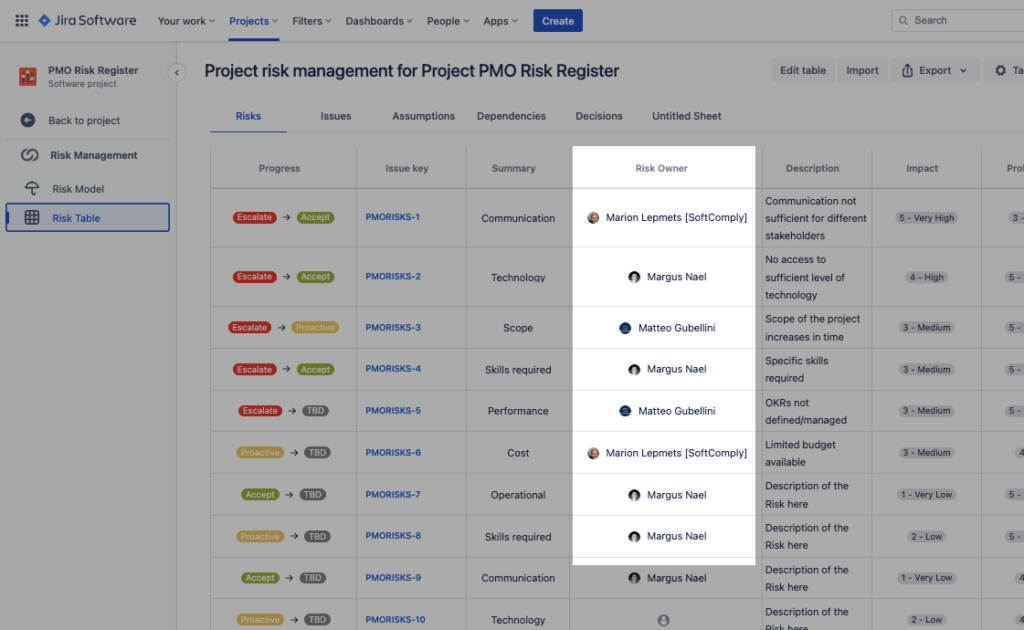
2. Always Up-To-Date Risk Register and Risk Reports
While Excel has good features for various diagrams (including those pivot tables that seem to be constantly breaking), Risk Management apps in Jira provide risk reports in Jira dashboards and in Confluence in seconds.
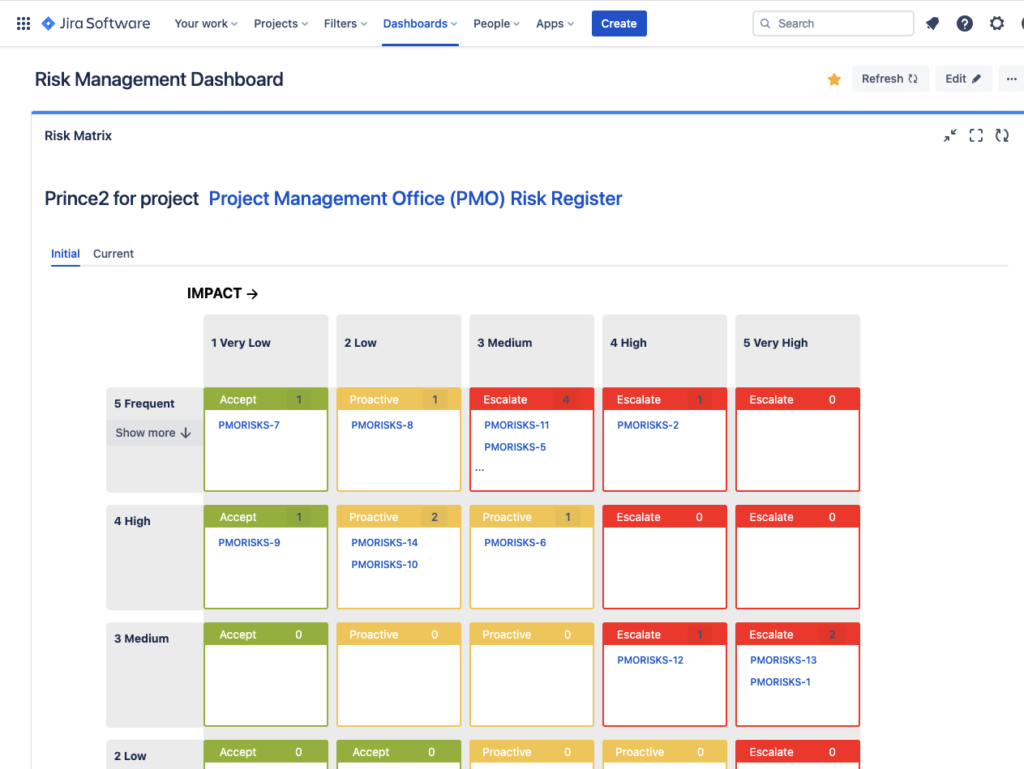
Furthermore, you can add risk reports to any of your team’s Confluence page. These reports are automatically updated in real time.
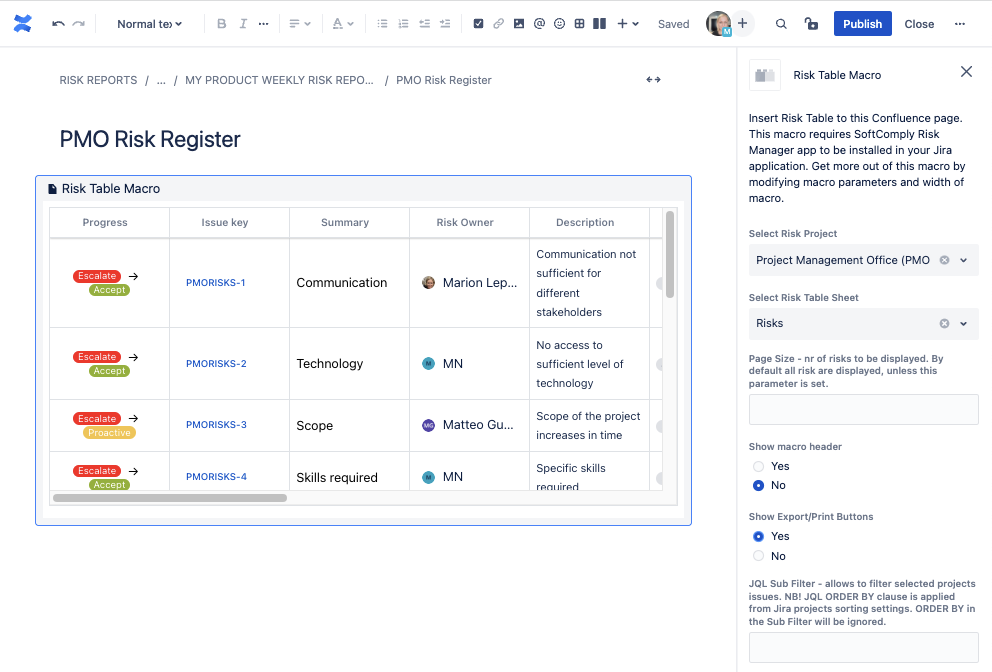
3. Empower your Team to Manage Risks Themselves
Let’s face it, a Risk Register in an Excel file buried four folders deep within your project governance doesn’t make it easy to find or know which file version is the latest to update. By empowering delivery teams to raise and mitigate their own Risks, Issues, Assumptions and Dependencies in the same Jira Project that they use to manage delivery every day, you get the potential to have a more proactive risk management culture.
You can keep different types of risks in different Sheets of the Risk Table for better risk management and overview:
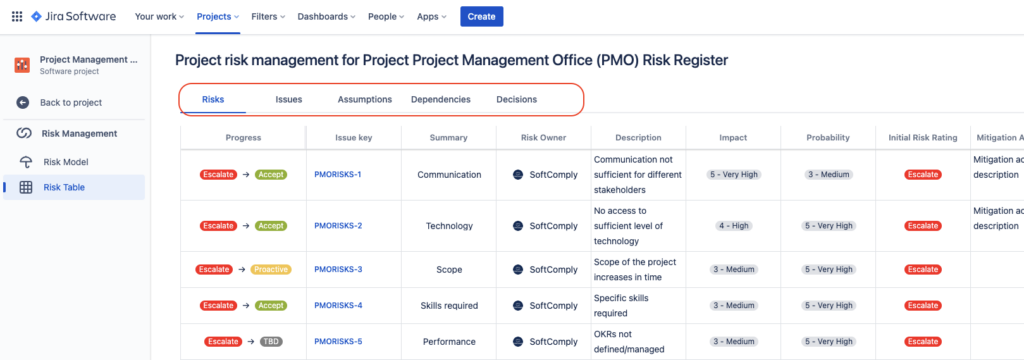
4. Risk History & Audit Trail
A Risk Register in Jira gives the ability to see the full history of who created, edited and worked on every risk item – it will make the Risk & Compliance department your best supporter. This is a necessary overview for any risk manager and a must-have for the Regulated Industries like Banking or the Medical Device industry.
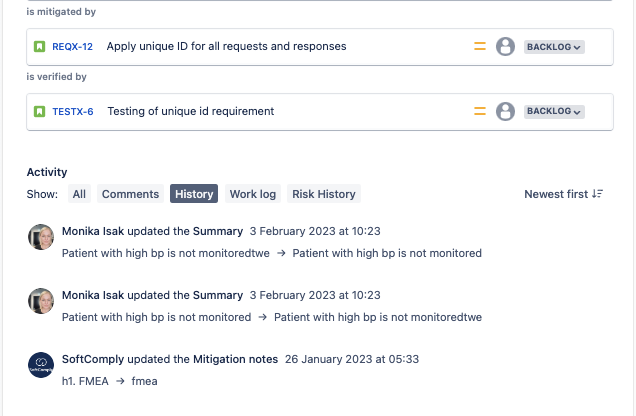
Key Features To Look for when choosing Risk Management plugin
- Scalable Risk Models
- Editable Risk Register to work with a number risks
- Ability to link several Risk Models to a Jira project
- Customisability to support variety of risk management frameworks
- Ready-made risk management templates to kick-start your risk management
- Onboarding live demos and support for setting up your risk projects
- Variety of Risk Reporting options
1. SoftComply Risk Manager Plus: Scalable, Customisable, Great Reports & Best Rated Risk App on Jira
User Rating
3.9 out of 4
Key features
Risk Manager Plus support managing different types of risks in one Jira project:
- manage your Enterprise, Information Security, Product and Project Risks in Jira Cloud;
- build global Risk Model and Risk Table Templates & assign them to your existing Jira projects for your risk management purposes;
- build 2- or 3-dimensional Risk Matrices;
- build Risk Model for RPN (Risk Prioritization Number);
- customise Risk Models with up to 10 user-defined Risk Characteristics (Severity, Likelihood, Detectability, etc);
- customise Risk Models with up to 10 user-defined Risk Iterations (Initial, Current, Target, etc)
- use several Risk Models in one Jira Project;
- build your custom Jira Risk Register – a Multi-Sheet Risk Table for managing all your risks in the same project;
- create an Object Register for risk related data that can easily be used in risk management across your organisation;
- track your progress in meeting the requirements of ISO/IEC 27001 & automatically generate the Statement of Applicability;
- report your risks in Jira Dashboard or in Confluence.
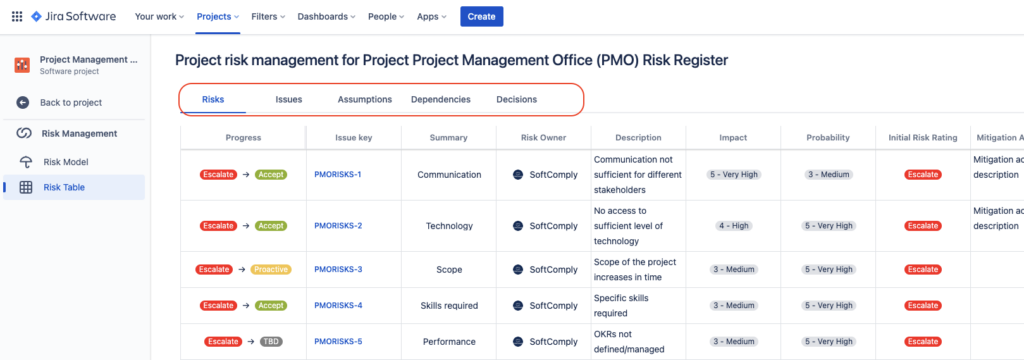
SoftComply Risk Manager Plus is the ultimate risk app on Jira Cloud supporting most risk management methods from Governance to IT Security risk management and everything in between.
Using the SoftComply Risk Manager Plus on Jira Cloud significantly speeds up your risk management through automation, especially when it comes to establishing traceability between risks and risk controls and test cases. With the Risk Manager Plus, you can manage all the different types of risks in one Jira project. You can also report risks in different ways – either using the Dashboard gadgets in Jira Dashboards or creating Risk Reporting macros in Confluence.
As with any Jira Cloud app, you can try it out for free for 30 days. SoftComply Support team is happy to help you set up your risk management the way you need in the Risk Manager Plus.
Pricing
Starts from 10 users at $35/month.
More details here: follow the pricing page at Atlassian Marketplace.
Ideal for:
- organizations from regulated industries
- organizations looking for one Jira plugin for various risk management frameworks
- for ISO 27001 risk management
- for ISO 14971 risk management
- for project risk management
- for RAID
- for migrating from Excel to Jira
- for safety-critical domains like Automotive, Aviation and MedTech
2. Hedge Risk Management: Intuitive, Great Support
User Rating
3.3 out of 4
Key features
Hedge Risk Management plugin on Jira Cloud is an easy-to-use risk management tool for simple project and product risks assessment developed by Appfire:
- supports customisable 2D risk matrix for risk assessment
- support customisable risk calculation formula
- supports assessment of risks in the Jira issue view
- you can also set the risk values for risks in the risk table/register view but other risk fields are not customisable in the risk table view.
- you can also set risk values directly in the risk matrix
- provides in-app risk reporting capabilities where you can see risk values per project either in inherent or residual risk matrix, pie chart, status report and risks raised overtime.
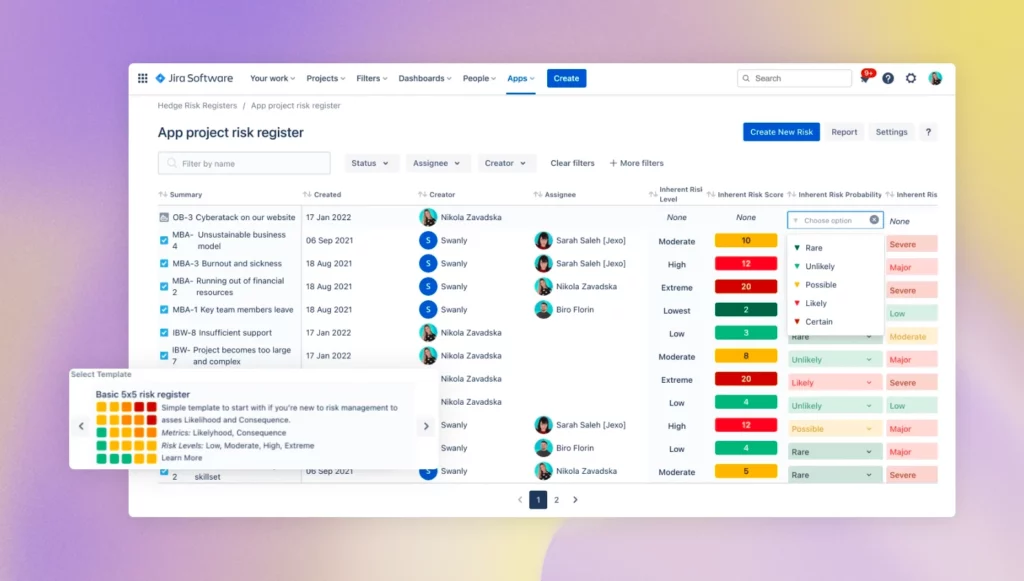
Pricing
Free for 10 users.
For details here: follow the pricing page on Atlassian Marketplace.
Ideal for:
- simple project risks
- small companies
- companies fluent in Jira
- companies that do not require risk reporting outside of Jira
- companies establishing their risk management processes
3. Risk Register: Configurable, User-friendly
User Rating
3.6 out of 4
Key features
- the very first risk management plugin developed on Jira supporting, primarily, project risk managers
- provides robust risk assessment capabilities in Jira issue views
- you can use and customise a 2D risk matrix and assign it to any Jira project
- you can assign risk values to each risk separately in a Jira issue view
- the app provides a view of risks in a list (risk register) but you cannot assign risk values directly in that view
- provides a dashboard view for risk reporting in which you can see the risks in inherent or residual risk matrix of your chosen project
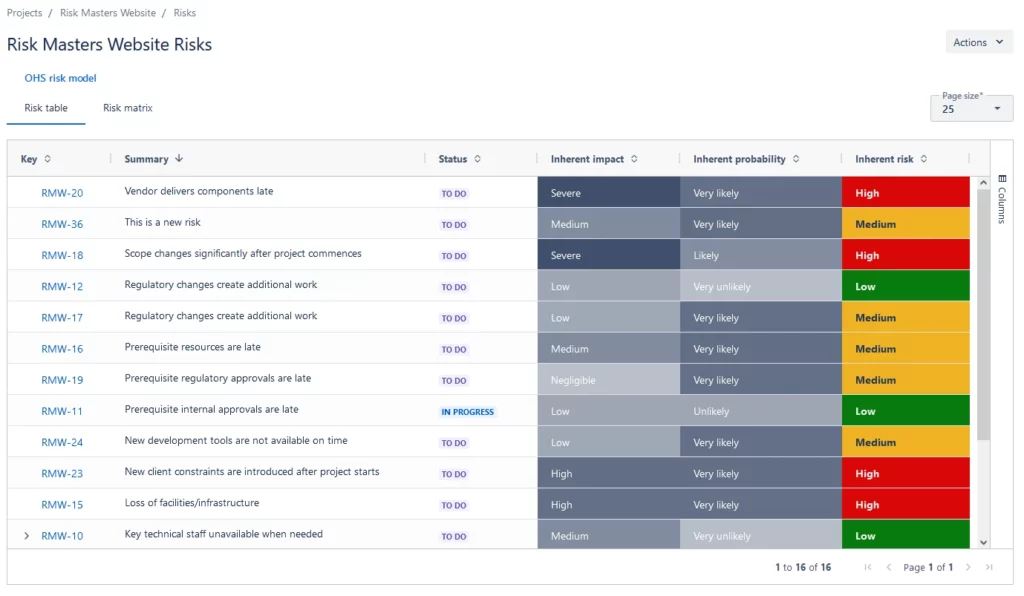
Pricing
Starts from 10 users at $5/month.
More details here: follow the pricing page at Atlassian Marketplace.
Ideal for:
- companies looking for a project risk management tool in Jira
- for ISO 31000 risk management
- companies fluent in Jira as risk editing and reporting are only in Jira
- configurable risk app in Jira
- companies using only a 2D risk matrix
Implementation Tips
Set Clear Processes
Before deciding on a risk management tool, you should establish a risk management process in your organization. This should provide a structured approach to identifying, assessing, and mitigating risks, ensuring that all team members understand their roles and responsibilities.
Having a risk management process not only supports consistency in your risk management efforts but it also facilitates communication and coordination among various departments, helping to align risk management activities with the company’s overall objectives and strategic goals.
Train Your Team
Training your team in risk management is another essential activity that you should invest in prior to deciding upon a risk management solution. The goal of the training is to implement the knowledge and skills needed to identify and respond to risks proactively. All team members should understand the importance of risk management and be familiar with the tools and techniques used to assess and mitigate risks.
By fostering a risk-aware culture, companies can enhance their ability to anticipate and manage potential issues, reducing the likelihood of disruptions and improving overall organizational resilience.
Once a risk management solution has been implemented in the organization, you should train your team in the solution so everyone knows how to use it. This can be done either internally or by requesting an onboarding training from the solution vendor.
Review and Update Regularly
Regularly reviewing and updating risks is vital for maintaining an effective risk management strategy in a dynamic business environment. As new risks emerge and existing risks evolve, continuous monitoring and assessment allows companies to adjust their risk management plans accordingly.
This proactive approach helps ensure that mitigation strategies remain relevant and effective, minimizing the impact of potential threats.
Most risk management solutions support automated reminders and notifications for approaching due dates to be set for regular risk reviews and mitigation actions.
Summary
🔄 Plugin Benefits Recap
SoftComply Risk Manager Plus stands out as a highly scalable and customizable risk management tool, offering comprehensive reporting features and robust support for managing various risk types within a single Jira project. Key functionalities include building global risk models, multi-dimensional risk matrices, and custom risk registers, along with automated ISO/IEC 27001 compliance tracking. Hedge Risk Management by Appfire, known for its intuitive interface and excellent support, facilitates simple project and product risk assessments using customizable 2D risk matrices and in-app risk reporting capabilities. Risk Register, the first risk management plugin for Jira, provides user-friendly and configurable project risk management, supporting robust risk assessments and dashboard reporting.
📌 Key Takeaways
SoftComply Risk Manager Plus significantly enhances risk management efficiency through automation and traceability features, making it ideal for regulated industries and organizations transitioning from Excel to Jira. Hedge Risk Management is suited for small companies and those establishing basic risk management processes, offering straightforward risk assessment and reporting within Jira. Risk Register is ideal for companies needing a project risk management tool, supporting ISO 31000 standards and providing customizable 2D risk matrices with a focus on risk reporting within Jira.
🔍 Choosing the Right Plugin
When selecting a risk management plugin for Jira, consider SoftComply Risk Manager Plus if you need comprehensive risk management across various frameworks and rigorous compliance tracking, especially in safety-critical domains like automotive and medtech. Opt for Hedge Risk Management if you seek an easy-to-use solution for simple project risks, particularly if your organization is small and prefers in-Jira risk reporting. Choose Risk Register if you require a configurable, user-friendly tool for project risk management, and if your team is comfortable with Jira-centric risk editing and reporting.





